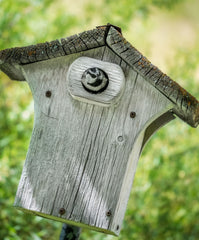Nest Box Week 2024
National Nest Box week was founded by the BTO and runs from February 14th through to the 21st. Birds are most likely paired up by around valentines day and are getting ready for their busy time of year, they will soon be looking for somewhere to nest from March to August.

More and more natural habitats are being destroyed to development plots, trees and hedges being cut down regularly. Lots of garden birds will struggle to find safe shelter to feed their young.
We have a range of nest boxes that could help our garden birds and provide them with a clean, warm, safe environment while looking after their young during breeding season.

There is no need to add any nesting material into the boxes as birds will do this on there own, this will usually take around 3 weeks. You can offer natural materials such as dog hair into a holder and hand it close to the nest box.
It's really important that birds have access to high-energy, high protein foods around the breeding season as birds will lose much needed protein whilst egg laying. They will also have to do double the food runs as they will also need to feed their young. Dried Mealworms and Suet are both great choices, but having a good variety including seeds and peanuts is good too. Please note if peanuts are left out, they need to be crushed to avoid any young birds choking.
Nest boxes don't need to look too fancy or have any detailing on them. We would advise picking one that is easy to clean.

Standard Nest Boxes
Place standard nest boxes north or east facing and under cover to avoid direct sunlight.
To try and attract woodpeckers, they need to be placed roughly 3-5 meters high from a tree with a clear flight path.
To attract sparrows and tits should be placed 2-4 meters high from a tree.
Standard nest boxes will attract blue tits, coal tits, great tits, marsh tits, woodpeckers, tree sparrows and pied fly catchers.
The opening needs to be smaller for blue tits, coat tits and marsh tits, a 25-28mm hole is ideal. While Great tits, tree sparrows, pied flycatchers and house sparrows will require a larger hole roughly 32mm.

Open Fronted Nest Boxes
Open fronted nest boxes are similar to standard boxes but with a much bigger opening at the front. Different species will prefer different size openings.
They should be placed north or east facing and under cover to avoid direct sunlight.
These open fronted boxes will attract robins, wrens, pied wagtails, and spotted fly catchers.
If you are looking to attract fly catchers the nest box will need to be placed 2-4m high and sheltered in vegetation on the tree but will need a clear view out.
For wrens and robins the box will need to be placed below 2m high and well hidden in vegetation.
Special Types of Nest Boxes
Starling Nest boxes
These boxes are made for starlings and great spotted woodpeckers, they are taller, wider and the opening needs to be around 45mm. The ideal location to place them is 2-4 meters high either on a tree or wall. Starlings usually like similar nesting locations to sparrows.
House Martin Nest Boxes
House Martins arrive back with us for the summer, nesting in mud-made nests built under the eaves of houses. Their numbers have declined dramatically in recent years so putting up an artificial mud nest box will help the population recover.
House martins which require small cups which are best placed high, preferably under the eaves of your house.

Helpful tips for adding nest boxes into your garden:
Avoiding direct sunlight and wind as this will will make the nest box more comfortable for birds and their young.
Try not to place nest boxes too close to feeders as this may attract predators such as squirrels and cats to the nest boxes.
Having more than one nest box will increase the chances of attracting birds to your garden, you could add different styles to try and attract different species.
It's best to clean out your nest box around October/November time when the birds will have likely migrated. Empty all the netting out to avoid parasites and use a hard brush to clean the inside.
When fitting your nest box, ensure it’s far away enough so birds are not disturbed by family pets, especially during breeding season.
Try not to place nest boxes too close to feeders as this may attract predators such as squirrels and cats to the nest boxes.
Having more than one nest box will increase the chances of attracting birds to your garden, you could add different styles to try and attract different species.
It's best to clean out your nest box around October/November time when the birds will have likely migrated. Empty all the netting out to avoid parasites and use a hard brush to clean the inside.
When fitting your nest box, ensure it’s far away enough so birds are not disturbed by family pets, especially during breeding season.
Don't forget that other wildlife also need homes through the year such as hedgehogs, bees and insects.









